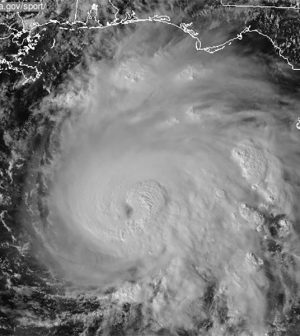- Navigating Your Midlife Crisis: Embracing New Possibilities
- City Raccoons Showing Signs of Domestication
- Mapping the Exposome: Science Broadens Focus to Environmental Disease Triggers
- One Week Less on Social Media Linked to Better Mental Health
- Your Brain Changes in Stages as You Age, Study Finds
- Some Suicide Victims Show No Typical Warning Signs, Study Finds
- ByHeart Formula Faces Lawsuits After Babies Sickened With Botulism
- Switch to Vegan Diet Could Cut Your Greenhouse Gas Emissions in Half
- Regular Bedtime Does Wonders for Blood Pressure
- Dining Alone Could Mean Worse Nutrition for Seniors
Warm Waters Raise Risk for Flesh-Eating Bacteria. Here’s Tips to Stay Safe

As waters warm across the United States and hurricanes and flooding season begins, the odds of being infected by flesh-eating bacteria are also rising, U.S. health officials warn.
According to a Sept. 1 health alert from the U.S. Centers for Disease Control and Prevention, a dozen types of the bacteria called Vibrio cause an estimated 80,000 such illnesses each year.
One particular type of bacteria, Vibrio vulnificus, can cause life-threatening “flesh eating” infections. About 150 to 200 of these infections are reported each year and about one in five of those infected die; sometimes within a day or two after becoming ill, the CDC noted in a news release.
Vibrio bacteria thrive in warmer water, especially during the summer months and when hurricanes hit. In the United States, infections have been mostly seen in Gulf Coast states.
Not surprisingly, infections in the Eastern United States have increased eightfold from 1988 to 2018 and moved up the coast by about 30 miles per year. Connecticut, New York and North Carolina have now seen severe and fatal infections.
Most people get infected by eating raw or undercooked shellfish, particularly oysters, the CDC warns. Some people, however, are infected when an open wound is exposed to the bacteria. Open wounds include those from recent surgeries, piercings, tattoos and other cuts or scrapes.
Coastal floods, hurricanes and storm surges can force coastal waters inland, putting people who are exposed to these waters at increased risk for vibrio infections.
The infection cannot be transmitted from one person to another, the CDC noted. Those at higher risk for infection include people with underlying health conditions, such as liver disease, diabetes and immuno-compromising conditions.
To prevent vibrio infections the CDC recommends:
- Stay out of salt water and brackish water if you have an open wound or cut. If you get a cut while in the water, leave immediately.
- If open wounds and cuts could come in contact with salt water, brackish water or raw or undercooked seafood, cover them completely with a waterproof bandage.
- Wash open wounds and cuts with soap and running water after contact with salt water, brackish water, or raw or undercooked seafood.
- Cook oysters and other shellfish before eating.
- Wash your hands with soap and water after handling raw shellfish.
- Get medical attention right away for infected wounds.
More information
For more on preventing vibrio infections, head to the U.S. Centers for Disease Control and Prevention.
SOURCE: U.S. Centers for Disease Control and Prevention, news release, Sept. 1, 2023
Source: HealthDay
Copyright © 2025 HealthDay. All rights reserved.










